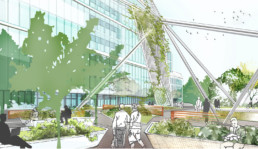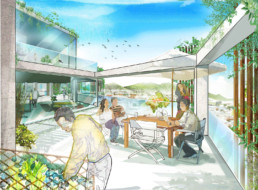Architectural considerations for post‐coronavirus
The fundamental relationship between home and work.

We are facing an epochal event. We have no idea of how long this emergency is going to last but we can try to understand and define what our world will look like when all of this will be finished. The world in which we want to live and thrive.
First, I would like to address the possible post-pandemic scenarios.
We have two options. The first is the catastrophic one. Many great experts tell us that everything will change, that our lives will no longer be the same and that we will have to adapt to live in a post-pandemic scenario that looks like the post-atomic environment shown in several films and books; if this is true, the world that we are used to will no longer exist: no more theaters, restaurants, squares, outdoor walks, football matches and so forth.
The second one, which in my mind is the most likely, sees the human being as a resilient creature that as well as every natural element takes its course, and , as always happens, improves itself making the most of the current situation.
After September 11th we should have stopped to travel. The same goes for all the great pandemics in history.
I believe that, instead, we will simply have to start living our daily lives dealing with a new important element: our personal wellbeing and the one of everyone around us.
Most probably we will defeat this disease. We will develop a cure. But, anyhow, we will have to deal with a big change in the way we live our daily lives, and this will be for good.
I do not want to focus on the sanitary aspects of this change. Instead I am interested in how this will affect the way we approach the design of the city, specifically commercial and residential buildings.
History is a great teacher. All the big changes in the way we conceive our cities are dictated by the need to improve the public health conditions and to fight epidemic like this.
Certainly, the main drivers will be the ever greater need to keep public health under control, and therefore to improve significantly the hygienic, cleaning and maintenance level of our buildings, and the lower propensity to physical movement aided by the new communication technologies which we are all learning to live with.
I consider it unlikely the hypothesis to reduce the density of our cities. Humanity cannot afford it. Cities like NYC, Tokyo, London, Hong Kong would no longer exist; countries like India, China (3 billion people) would not survive. Trying to imagine how our physical environment (cities, residencies, offices) could evolve toward I can definitely see better quality and dimensional standards that would provide a sustainable answer to the big economic and social challenges the entire humanity is facing in these times.
Will our homes change accordingly? I think so. At least I hope so.
We have been forced to use them more than what contemporary economy imposed us in the last years.
Tiny apartments where few members of an increasingly shrank family must spend less and less time if not to sleep. I think we should start thinking about having a dedicated space for working, a room or a quite corner, increase the dimensions and improve space flexibility to carry out safe social activities, and to grow up our children.
Rethink the entrances as a filter that can be used for safe deliveries or as decontamination space where who access the apartment can wash hands, change shoes, leave coats…
At the semi-private level, I see the need to integrate common services, on the US model, which would allow to maximize the space inside the houses by keeping the amount of private square meters unchanged.
Co-working spaces, first aid, nurseries equipped with advanced diagnostic devices to monitor the wellbeing of the inhabitants and much more.
Having semi-public outdoor areas is already a growing trend which responds to the demand of spaces for playing, cultivate a small vegetable garden, outdoor activities, relax areas and so forth.
Talking about workplaces, I strongly believe they will undergo major changes as well, especially offices. The drivers will necessary be the following:
Need for hygiene.
Greater use of remote working.
Reduced demand for business travel.
Need for greater distance between workers.
What does this translate into? Probably the need for higher hygiene standards entails higher maintenance costs, but, combined to the lower real estate costs and the lower expenses for business trips, will lead to a natural optimization of the office costs and maybe to new and more advanced forms of co-working.
Also, the typical layout will change, allowing for more individual spaces equipped for online meetings with the latest telecommunication technology and advanced audio / video systems.
Large companies will be able to set up a more efficient structure without investing in large campuses and implementing new widespread and neighborhood friendly networks of multipurpose spaces which could be used by the community during non-working hours.
Small, flexible offices, hyper-connected and scattered throughout the city, close to employees’ houses.
Probably there will be health scanners at the entrance and it will be the security that will not let us in if we are not feeling well instead of forcing people to attend work even if sick.
Another effect of the current situation will be visible on larger common areas, hallways, lobbies, vertical transportation and more restrictive occupational standards. Is this the end of high-rise buildings era?
The relationship between back-of-house and front-of-house with the increased demand for spaces dedicated to services had already undermined the economic sustainability of such kind of super-structures.
Certainly, we need to rethink the ventilation systems for our offices, both natural and mechanical which will increasingly be microbiologically controlled with the same systems already in use on some new cars, equipped with anti-bacterial micro-filters suitable for bacteriological attacks (!).
Especially in closed environments such as lifts, toilets etc. the standards should be raised to the one used for hospitals and other sanitary structures. Desks’ size will go back to 180 cm instead of the actual 140.
Even the world of healthcare will change significantly.
Smaller structures, closer to residential areas to decongest hospitals which will focus on serious cases and emergencies, multiple diagnostic facilities, increased health standards at home and in the workplaces.
Extended care will certainly have to be thoroughly rethought, having to guarantee the highest safety standards. My hope is that, instead of isolating ourselves even more than what we are now, becoming more and more addicted to our smart phones we will accept the challenge and use this pandemic as an opportunity to transform darkness into light, to improve our perspective and to rethink the way we live and design our cities, homes, offices and schools.
